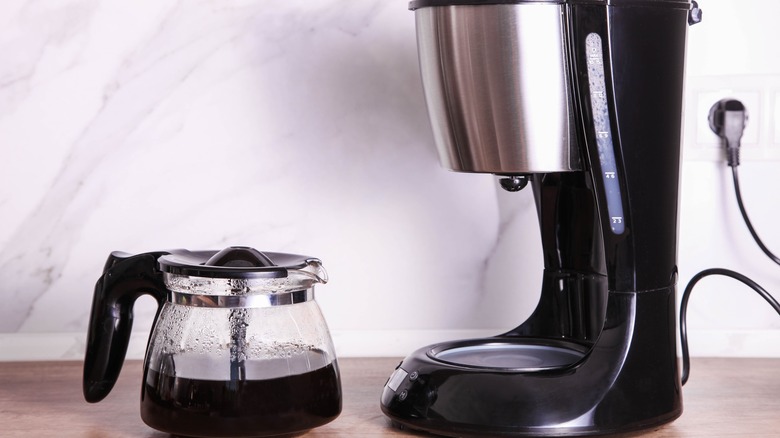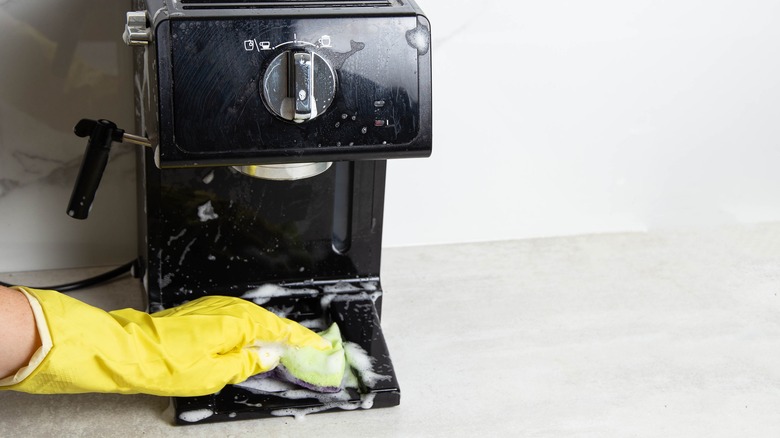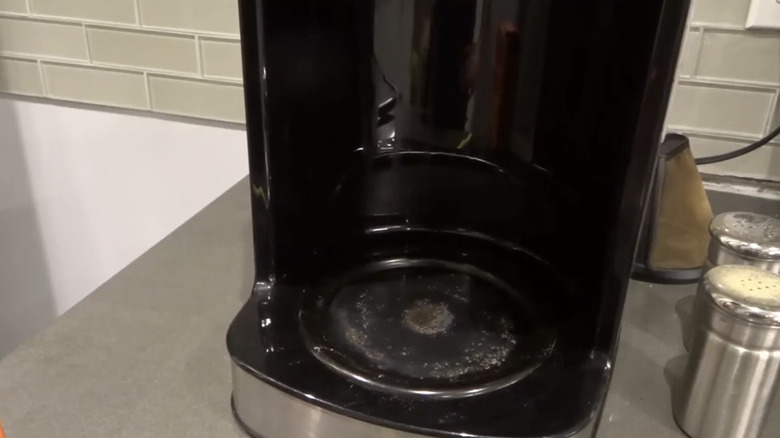The Best Method For Cleaning Your Burnt Coffee Pot Burner
Coffee is the key start to many of our mornings, and sometimes our afternoons too. Our drip coffee machines go through a lot, and cleaning them thoroughly is necessary to keep them functioning properly. Surely you make sure to thoroughly hand wash the coffee pot, ground holder, and reusable filter. You might even be on top of your game and regularly descale your coffee maker's water tank every now and then. But take a look at the burner that keeps your coffee warm. When's the last time you gave it a good wash? And if you have, you might not be doing it properly.
Burners deal with all of the staining from spilled coffee and hard water that the other parts of the coffee machine do, but then these spills are hardened when exposed to the high temperatures. Thankfully, cleaning a coffee machine burner is actually pretty simple, and you only need a few basic ingredients such as baking soda, lemon juice, and water to eliminate burnt coffee buildup and stains. Here's how to get your coffee machine's hot plate looking fresh and clean in just a few steps.
Use baking soda and water
To give your burner plate a basic cleaning, baking soda and water can go a very long way. Baking soda is slightly alkaline, which is great for breaking down the acids in coffee. In addition to the chemical composition, baking soda is also gently abrasive, which aids in physically removing the burnt, dried-on splotches.
Before you get started with cleaning, make sure the coffee maker is off and the burner has fully cooled down. Only attempt cleaning several hours after your coffee pot was last on, and unplug it for safe measure. Add a teaspoon of water and 2 to 3 teaspoons of baking soda onto the burner. Using a small scrub brush or old toothbrush, work the ingredients into a paste. You should see the brown residue quickly lift, but you may need to scrub for a few minutes at a time. After the baking soda has dissolved and the coffee has been removed, use a damp cloth to wipe the burner down thoroughly.
Even with the burnt bits of coffee gone, you might still find hard water stains, and baking soda can't really tackle these. You'll need a pantry staple acid, but ditch the vinegar for cleaning your coffee machine. Instead, use half a lemon to work through the more stubborn mineral deposits, followed by dish soap to eliminate any greasy residue. This should leave you with a nicely polished burner plate in the end.
What to do for rust on a coffee burner plate
If there's been a lot of buildup on your coffee burner plate and the coating on the surface has worn away, you may be dealing with some rust. Because your coffee pot burner isn't in direct contact with any food or drinks, rust doesn't mean you necessarily need to throw it out, but you do still want to clean it since rust can spread, become jagged and further damage your coffee machine, and flake off, creating a potential health hazard in your kitchen.
To tackle rust, you want to use an acid-based cleaning product. There are plenty of store-bought rust cleaners available, but to avoid using harsh chemicals that might further corrode the burner's finish, stick to lemon juice and/or vinegar. Because baking soda and vinegar neutralize each other, mix in regular table salt to erode any stubborn rust. You can also try tackling the rust stains with a non-scratching scouring pad for extra grit. Don't use steel wool or other harsh scrapers on the burner, as this can further damage the surface. These cleaning methods will make your rusty coffee maker hot plate like new again.
Prevent rust and other hardened coffee stains by not allowing coffee to sit on the burner for extended periods of time. Consider making wiping down the burner with a wet cloth a part of your nightly kitchen cleaning routine so the stains don't become further set in over time.


